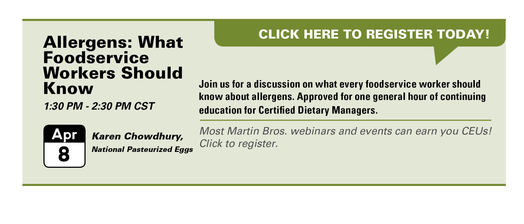
There’s no doubt about it. Allergies are on the rise. Therefore, we must prepare staff to handle allergen questions and issues. Here are four tips to help empower your staff to handle allergens as well as help your facility cater to people with allergies.
Food Allergy - The National Institute for Allergy and Infectious Disease (NIAID) definition:
“A food allergy is defined as an adverse health effect arising from a specific immune response that occurs reproducibly on exposure to a given food.”

Know “the big eight” allergens, which are milk, tree nuts, peanuts, soy, wheat, fish, shellfish and eggs, and know the symptoms that may occur due to a reaction from them. Symptoms may include but are not limited to: hives, swelling, itching, tingling, vomiting, diarrhea, throat tightness, coughing, wheezing, sneezing, runny nose and cardiac arrest.

Read the labels on your cases to find out which allergies are present or potentially present in your food. If you’re looking for allergen-free foods, Martin Bros.’ customer website (https://customer.martinbros.com/) and many manufacturer websites give you the ability to search for and find lists of allergen-free items. All information is maintained by the manufacturers. It is also important to regularly review your products, as manufacturer formulations and production locations can change without notice at any given time. It does help, however, that ingredient labels have improved greatly in just the past few years with new legislation requiring “the big eight” allergens to be claimed on the food label. If an item has or could have one or more of “the big eight” allergens, at the end of the ingredient statement, it should state that the product contains or may contain that or those allergen(s).

Cross-contamination is the biggest concern in regards to food safety when we address food allergies. Consider a separate area of the kitchen to prepare non-allergen items. Invest in allergen equipment and supplies, which are usually purple in color. The purple color is designed to color-code and alert kitchen staff to follow special food allergen prep procedures.

Reassure customers that you can meet their needs. Promote that you can meet their needs in many different ways, including online. Many review sites include searches for restaurants that are gluten-free friendly, for instance. Many people with allergies are either leery of dining out or savvy about finding places that can safely serve them. So, if you’re allergen-friendly, make sure you get the word out.







